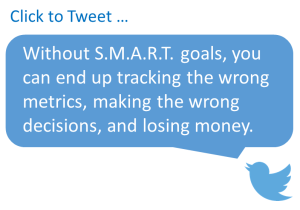
Metrics Drive Decisions
Today, marketing is all about metrics. Metrics drive all your marketing actions from …
- When, where, and how much to spend on online advertising
- Which ad copy and graphics to use
- Determining which products and resources to further invest in or discontinue
With so much emphasis and decision making based on metrics, you want to make sure you are collecting and measuring the right data. Unfortunately, many businesses are not.
Goals Before Metrics
In order to know which metrics matter for your online paid ad campaigns, you first have to know your goals. Without S.M.A.R.T. goals (Specific, Measurable, Attainable, Relevant, Timely Goals), you could end up tracking the wrong metrics, making the wrong decisions, and wasting/losing money. To learn more about the importance of goals, check out one of our previous posts 1st Step to Online Success - Determine Your Goals & Metrics.
Maybe you’re an eCommerce business and the main goal of your online paid ad campaign is for visitors to purchase products on your site. Maybe you don’t sell products directly from your website and your goal is for visitors to download your eBook, fill out a form, or call you directly. Or, maybe your goal is to simply raise awareness about your brand or a specific topic. For the sake of this article, let’s break down the metrics relevant to receiving a certain number of conversions, like calls for Search (PPC) and Display (CPM or PPC) online ad campaigns.
Top Metrics for Search and Display Paid Ad Campaigns Focused on Increasing Calls from Prospects
1. Conversions (Calls)
A conversion is any action you want visitors to take on your site. In this example, you want visitors to call your business. Since this action is the actual goal, it is the most important metric to track. If your online ad campaign never results in any calls, then the campaign was not a success. Evolve Your Website With Conversion Optimization offers advice on how to increase conversions from visitors once they land on your site.
To accurately track your calls, I suggest using CallRail. This program is very affordable and integrates well with Google Analytics.
2. Conversion Rate
The conversion rate is the amount of conversions your ads receive divided by the amount of clicks (sessions) your ads receive. The conversion rate of an ad tells you how relevant your offer is in terms of what visitors want and expect, and if they are in the right stage of the buyer journey to make that conversion. Usually, the more appropriate your conversion is for the visitor's stage in the buyer journey, the higher the conversion rate.
3. Cost Per Conversion
Cost per conversion is the amount you spent for every conversion you receive. You always want to achieve your desired profit after subtracting the cost of goods sold and the ad spend from your revenue. The lower your cost per conversion, the higher the return on your investment (ROI).
If you spend $500 on an online ad campaign and you receive 5 calls, each one of those calls cost $100. Depending on how much each sale is worth will determine if the ads yield the desired ROI. If you sell high value offerings worth $10,000 per sale, this may have been worth the investment. If you sell lower value offerings worth $200 or less per sale, this may not have been worth the investment.
Related post: How to determine your ideal cost-per-click
4. Click Through Rate (CTR)
Click through rate (CTR) is the amount of clicks your ads receive divided by the amount of impressions (views) your ads receive. The CTR of an ad tells you how relevant your ad is in terms of what viewers want and when they want it. Usually, the more relevant your ad the higher the CTR.
You may hear people say 2% is the average universal search CTR. Do not use this as a measure to determine the success or failure of your campaigns. The truth is CTR’s vary greatly between industries, channels (Google, Facebook, LinkedIn, Email), and types of offers. Some campaigns may be successful and only have a CTR of 0.1% while other campaigns may not be successful without a CTR of 10% or higher.
5. Clicks
Clicks are the total amount of times someone clicks on your ad. This metric can be used to determine the volume of traffic your ads are bringing to your website. If you notice a large volume of clicks, but a low volume of conversions, your landing page (the page visitors land on after clicking your ad) may not be what visitors are expecting. If this is the case, you may need to edit your ads or your landing page to better match one-another.
6. Total Cost
Lastly, how much did you plan to spend and what did you get for your money? Most popular online advertising channels allow you to set daily spend maximums so you don’t go over your budget. Usually it’s great to save money, but if you’re not spending your full budget there may be several potential issues with your campaign.
If the cost per click (CPC) was less than predicted, that could be good. However, a lower CPC should mean you can receive a higher volume of clicks still reach the expected daily spend. For search campaigns, first make sure your ads are showing on first-page results. If they’re not, you may need to increase your keyword bids (for search campaigns). After that, if you’re still not spending your expected amount because you’re not receiving enough clicks, you may need to edit your ads to take the copy more relevant and attractive to searchers.
It All Depends
I know it's not what you want to hear, but at the end of the day, the metrics that matter for your online search and display paid ad campaigns all depend on the specific goals you’re trying to reach. But, no matter what, it all comes down to these 6 steps:
- Determine S.M.A.R.T. Goals.
- Determine which metrics are needed to measure the success of those goals
- Use applications that accurately record the metrics you need.
- Regularly track and record those metrics, while making small improvements along the way.
- Analyze the data and draw conclusions.
- Use the learnings to repeat for the next paid online ad campaign.
[hs_action]
If you found this article helpful, you may also be interested in ...
5 Simple Ways to Measure Offline Campaigns Online
Three Digital Tactics with High Failure Rates, and How to Avoid Them
Measuring Offline Marketing Using Google Analytics
Web Analytics - Creating a Foundation for Marketing Success






Agree, disagree, or just have something to add?
Leave a comment below.